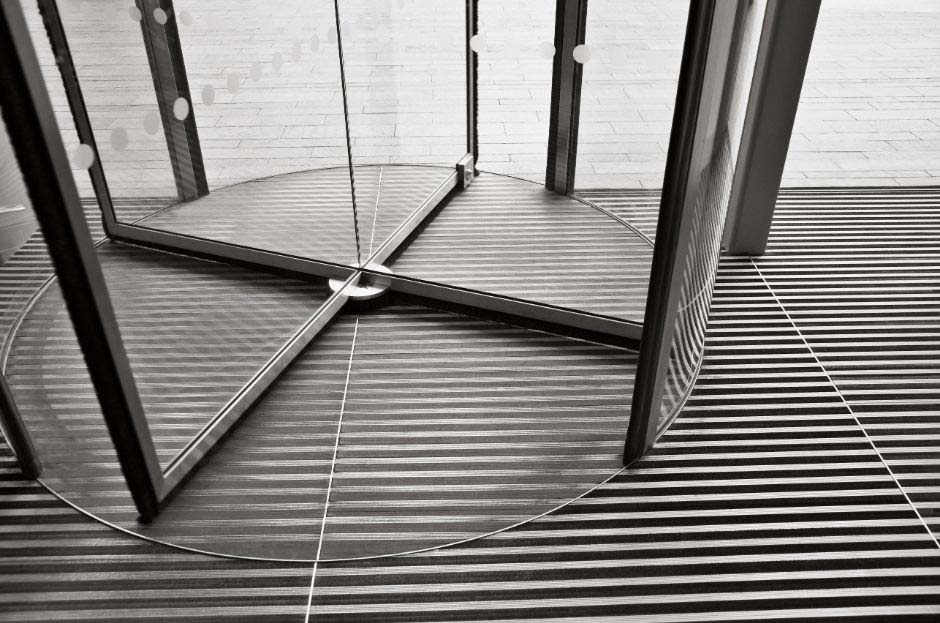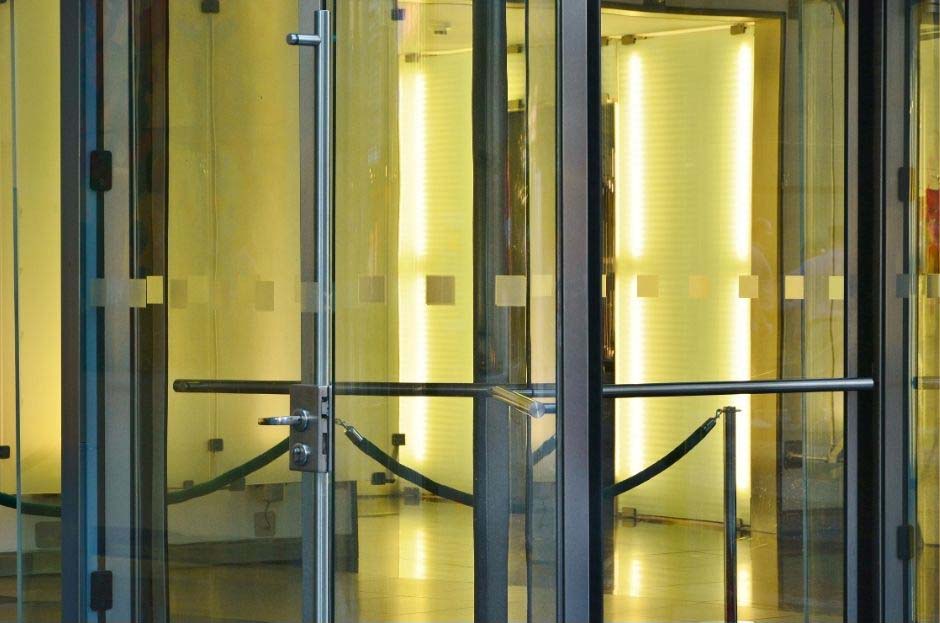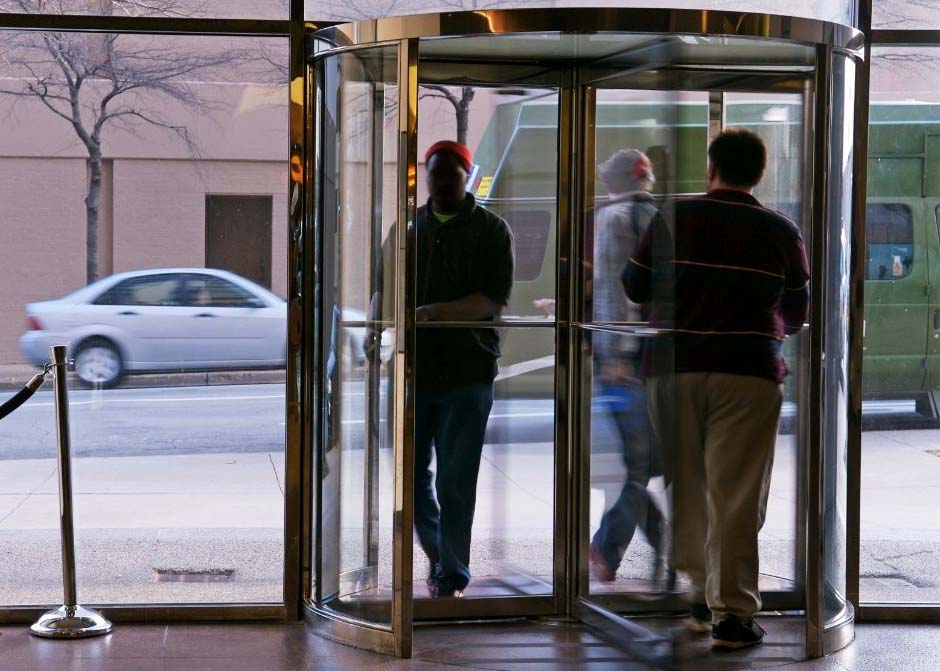Counting on a revolving door for your business can surely bring lots of customers. However, you must also be aware of its speed of rotation. That’s why today we’ll share with you some revolving door speed control tips! That way, you’ll prevent your door from rotating faster or slower than it should.
How Does the Control Mechanism for Revolving Doors Work?

When a premise counts on a rotating door as their main entrance, business owners must ensure that the door abides by national standards. By doing so, they make sure that the building relies on a safe and efficient entryway in case of emergencies.
As most of us know, revolving doors grant businesses a wide range of perks. Some of these include better traffic flow and lower utility costs. For this reason, many companies tend to opt for them, especially airports, hotels, and office buildings.
Nonetheless, to acquire these benefits, the revolving door installed should have a quality speed control device. In other words, it should handle without any problem all types of traffic flow that may pass through it. This flow ranges from people to small vehicles.
Generally speaking, you can find a revolving door speed control mechanism or governor over the door’s canopy. Alternately, you may also opt for a control device on that’s floor mounted. This option tends to work best when having a rotating door that has a glass ceiling.
Along with this mechanism, a rotating door counts on a deadbolt lock system to secure the door’s wings. This revolving door lock system can be placed on the top rails or under the door. Usually, bottom locks tend to be for doors that are higher than 7.5 feet.
In a nutshell, a revolving door’s speed control mechanism should guarantee that the door is simple to use and verifies positive access control. Moreover, the mechanism of the present must make sure that the door wings’ speed remains constant. Lastly, it should provide quarter-point periodic stopping.
Difference Between Automatic and Manual Revolving Door’s Rotation
 The rotation of a revolving door varies depending on its type. Most business owners tend to opt between a manual and an automatic revolving door.
The rotation of a revolving door varies depending on its type. Most business owners tend to opt between a manual and an automatic revolving door.
Manual Revolving Door Speed Control
Manual rotating doors require a control device to limit their rotation speed. Not only that, but they must also have an option that allows them to collapse. As a result, the building will rely on a well-planned doorway that’ll allow safe emergency egress.
Automatic Rotating Door Speed Control
On the other hand, automatic revolving doors must rely on a motor driving mechanism and electric sensors.
First, the sensors can detect any person that’s reaching for the door as well as any person leaving. Additionally, these electric sensors help prevent the door from rotating due to other elements, such as strong winds.
There are two types of safety sensors your revolving door should have:
- The main electric sensor
- A back-up sensor
Moreover, these sensors must be placed at various key locations on your door, such as the door wings, top rails, and mounted ceilings.
We then have the motor drive and clutch assembly devices.
Both of these tools connect to the centrifugal brake assembly, which ultimately is the part of the revolving door that controls the speed.
In older models, this brake often stopped the door whenever it started to rotate too fast. However, present inventions and newer models count on an improved speed control mechanism. These devices usually avoid the revolving doors ever exceeding such motion.
When counting on a modern rotating door, you’ll be able to choose the speed that best fits your place.
For instance, if you have a store that doesn’t have too much traffic on its entryway, then you can adjust the door’s speed to 4 R. P. M. (Revolutions per minute). On the contrary, if you’ve got a business that has clients continually entering and leaving the premise (such as an airport), then you can set the speed up to 12 R. P. M.
Lastly, the perimeters and central shaft of this revolving door type often power the door when operated. In this manner, they minimize and prevent any abrupt impacts that may happen.
Of course, you can adjust all of these settings according to your business.
Things to Consider for an Optimal Revolving Door Speed Control

If you want to avoid people getting stuck while using your revolving door, then there are several things you should do to ensure their safety and comfort.
These are the main things to keep in mind when it comes to the revolving door speed control:
- Identify your business traffic type capacity.
- Establish your revolving door’s size and dimensions.
- Check your door’s throat opening.
- Look for complementary surroundings.
- Consider an optimal position for manual rotating doors.
Identify Your Business Traffic Type Capacity
You must first know how much people tend to go to your business. By doing so, you can recognize if you need a one-way or a two-way door.
Customarily, two-way doors can handle more than double the number of people compared to the one-way design. For instance, while a one-way door can take only 15 people per minute, the two-way style can manage 24 persons per direction. This translates to up to 48 people per minute!
Establish Your Revolving Door’s Size and Dimensions
Along with the door’s design, you must also establish if your business needs a small or a large revolving door.
Automatic doors tend to present better traffic flow when having a larger diameter. On the flip side, manual revolving doors with greater diameter tend to provide better comfort for clients. This is because wide revolving doors tend to have more compartment space.
Bear in mind that larger revolving doors tend to weigh much more. This extra weight can have an impact on the number of people going through it.
Check Your Door’s Throat Opening
Next, we have a rotating door’s throat opening.
A larger throat opening often means increased user capacity and comfort. This principle becomes more prominent when having a small revolving door for your business.
Typically, 4-winged doors tend to have a wider throat opening compared to the 3-winged design. Not only that, but three-wing doors also tend to perform poorly in emergencies.
Look for Complementary Surroundings
As a rule of thumb, business owners must place an overhang for the door. That way, rain and snow will not get inside the premises.
Additionally, it’s best to count on an interior throat opening.
Finally, the flooring should count on matting materials to avoid any falls or slips.
Consider an Optimal Position for Manual Rotating Doors
Lastly, if you’ve got a manual door for your premises, consider leaving the wings in an “x” position. You can do so by configuring the drive system. This position allows users to have a better time using the door.
Now that you know how a revolving door speed control mechanism works, you’ll now provide a safe passage for your clients to your business. Remember to apply the essential tips we mentioned in this article to ensure your customers’ optimal experience.

